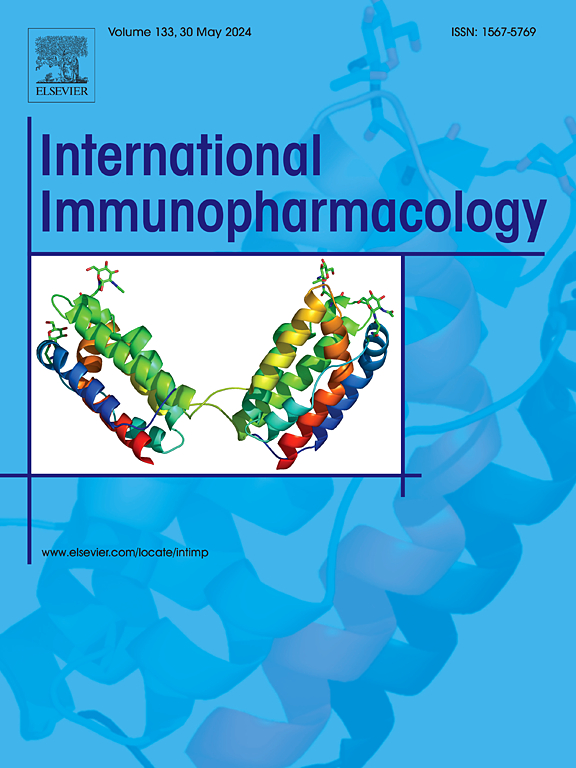Cyclopamine inhibits corneal neovascularization and fibrosis by alleviating inflammatory macrophage recruitment and endothelial cell activation
IF 4.8
2区 医学
Q2 IMMUNOLOGY
引用次数: 0
Abstract
Purpose
To explore the function of cyclopamine in corneal neovascularization and subsequent fibrosis after cornea alkali-burn injury.
Methods
In vivo, mice cornea were injured by NaOH, and then treated with cyclopamine, clodronate liposomes (CLO-LPS), and vehicle of cyclopamine separately by subconjunctival injections. Clinical features were observed and pathological characteristics were examined. In vitro, M1 macrophages (M1φ) and human umbilical vein endothelial cells (HUVECs) were co-cultured, and the abilities of proliferation, migration, and tube formation of HUVECs were detected under different interventions of M1φ.
Results
Alkali-burn injury induced massive angiogenesis and decreased transparency of the cornea, along with numerous macrophages infiltration and Shh protein expression in the cornea. However, corneal neovascularization, macrophage infiltration, and Shh expression could suppressed by cyclopamine and CLO-LPS significantly. In addition, treatment with cyclopamine also reduced the expression of inflammatory factors (TNF-α, IL-6) and fibrosis factors (VIM, α-SMA). In vitro, M1φ promotes migration and tube formation of HUVECs by secreting Shh protein, which could be inhibited by cyclopamine.
Conclusion
Cyclopamine could suppress inflammation and angiogenesis of alkali-burned cornea, as well as subsequent fibrosis. The study reveals that cyclopamine suppresses corneal neovascularization in a dual mechanism of inhibiting macrophage infiltration and suppressing Shh signaling.
环戊巴胺通过减轻炎性巨噬细胞的招募和内皮细胞的活化,抑制角膜新生血管和纤维化。
目的:探讨环巴胺在角膜碱烧伤后角膜新生血管形成及纤维化中的作用。方法:在体内用NaOH损伤小鼠角膜,结膜下分别注射环巴胺、氯膦酸脂质体(clol - lps)和环巴胺载体。观察临床特征和病理特征。在体外,将M1巨噬细胞(M1φ)与人脐静脉内皮细胞(HUVECs)共培养,检测不同M1φ干预下HUVECs的增殖、迁移和成管能力。结果:碱烧伤引起角膜大量血管生成,角膜透明度降低,角膜内巨噬细胞大量浸润,Shh蛋白表达增多。而环巴胺和CLO-LPS可显著抑制角膜新生血管形成、巨噬细胞浸润和Shh表达。此外,环巴胺治疗还降低了炎症因子(TNF-α、IL-6)和纤维化因子(VIM、α-SMA)的表达。在体外,M1φ通过分泌Shh蛋白促进HUVECs的迁移和管状形成,而环巴胺可以抑制这一作用。结论:环巴胺能抑制碱烧伤角膜的炎症和血管生成,并能抑制碱烧伤角膜的纤维化。本研究揭示环巴胺通过抑制巨噬细胞浸润和抑制Shh信号的双重机制抑制角膜新生血管形成。
本文章由计算机程序翻译,如有差异,请以英文原文为准。
求助全文
约1分钟内获得全文
求助全文
来源期刊
CiteScore
8.40
自引率
3.60%
发文量
935
审稿时长
53 days
期刊介绍:
International Immunopharmacology is the primary vehicle for the publication of original research papers pertinent to the overlapping areas of immunology, pharmacology, cytokine biology, immunotherapy, immunopathology and immunotoxicology. Review articles that encompass these subjects are also welcome.
The subject material appropriate for submission includes:
• Clinical studies employing immunotherapy of any type including the use of: bacterial and chemical agents; thymic hormones, interferon, lymphokines, etc., in transplantation and diseases such as cancer, immunodeficiency, chronic infection and allergic, inflammatory or autoimmune disorders.
• Studies on the mechanisms of action of these agents for specific parameters of immune competence as well as the overall clinical state.
• Pre-clinical animal studies and in vitro studies on mechanisms of action with immunopotentiators, immunomodulators, immunoadjuvants and other pharmacological agents active on cells participating in immune or allergic responses.
• Pharmacological compounds, microbial products and toxicological agents that affect the lymphoid system, and their mechanisms of action.
• Agents that activate genes or modify transcription and translation within the immune response.
• Substances activated, generated, or released through immunologic or related pathways that are pharmacologically active.
• Production, function and regulation of cytokines and their receptors.
• Classical pharmacological studies on the effects of chemokines and bioactive factors released during immunological reactions.

 求助内容:
求助内容: 应助结果提醒方式:
应助结果提醒方式:


